Soft Tissue Techniques / Joint Mobilizations
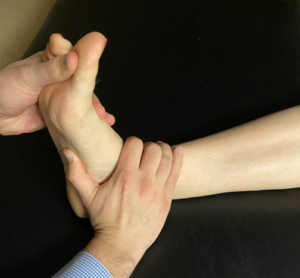 Manual therapy is a service provided to the patient that is performed to manage musculoskeletal pain, improve mobility, and restore function. Techniques can vary dependent on the type of pain the patient is presenting with. The therapist will consider clinical findings in the assessment and select the approach that would be most beneficial. Usually this is based on the symptom presentation and etiology of injury that would aid in the proper intervention. Soft tissue techniques help with tissue extensibility, increased blood flow, and joint motion. Research shows that joint-based techniques can help reduce pain and inflammation by inhibiting the pain messages sent by the central nervous system. There are various techniques based on the joint or area the therapist treats, but this passive technique may be an integral part of the rehabilitation process.
Manual therapy is a service provided to the patient that is performed to manage musculoskeletal pain, improve mobility, and restore function. Techniques can vary dependent on the type of pain the patient is presenting with. The therapist will consider clinical findings in the assessment and select the approach that would be most beneficial. Usually this is based on the symptom presentation and etiology of injury that would aid in the proper intervention. Soft tissue techniques help with tissue extensibility, increased blood flow, and joint motion. Research shows that joint-based techniques can help reduce pain and inflammation by inhibiting the pain messages sent by the central nervous system. There are various techniques based on the joint or area the therapist treats, but this passive technique may be an integral part of the rehabilitation process.
IASTM / Scraping
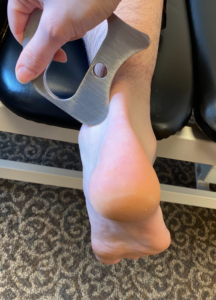 IASTM, commonly termed “scraping,” is used to break down tissue restrictions resulting from periods of immobilization, surgical interventions, or trauma. With controlled microtrauma to the affected structure, IASTM stimulates a localized inflammatory response. At a cellular level, there is a reabsorption of adhesions or excess scar tissue. This leads to the soft tissue structure healing through reorganization of collagen fibers. When these restrictive tissues are broken down and remodeled in this fashion, patients are able to regain pain free motion that was previously limited.
IASTM, commonly termed “scraping,” is used to break down tissue restrictions resulting from periods of immobilization, surgical interventions, or trauma. With controlled microtrauma to the affected structure, IASTM stimulates a localized inflammatory response. At a cellular level, there is a reabsorption of adhesions or excess scar tissue. This leads to the soft tissue structure healing through reorganization of collagen fibers. When these restrictive tissues are broken down and remodeled in this fashion, patients are able to regain pain free motion that was previously limited.
To further your studies on the physiological benefits of IASTM, please refer to the Journal of Exercise Rehabilitation for an overview of research gathered.
Jooyoung, J., Sung, D. J., & Lee, J. (2017). Therapeutic effectiveness of instrument-assisted soft tissue mobilization for soft tissue injury: mechanisms and practical application. Journal of Exercise Rehabilitation, 13(1), 12–22.
Suction Cup Assisted Scar Tissue Mobilization
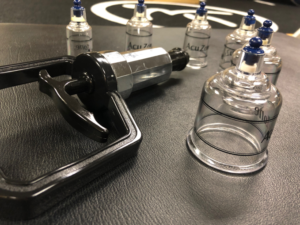 SASTM uses negative pressure forces with suction cups to lift the tissues which creates space within the tissue layers for improved gliding and mobility. Decompression helps release tight tissues, improve the pain associated with trigger points, improve blood flow and nutrient exchange, and create a change to the neuromuscular system which allows for temporary pain relief. SASTM can also help improve scar mobility by releasing connective tissue adhesions which will speed up recovery times and improve movement quality. SASTM can be used for a multitude of conditions including the following: contractures, scar adhesions, post-surgical recovery, muscle and movement imbalances, tendinopathy, postural issues, pain, and trigger points.
SASTM uses negative pressure forces with suction cups to lift the tissues which creates space within the tissue layers for improved gliding and mobility. Decompression helps release tight tissues, improve the pain associated with trigger points, improve blood flow and nutrient exchange, and create a change to the neuromuscular system which allows for temporary pain relief. SASTM can also help improve scar mobility by releasing connective tissue adhesions which will speed up recovery times and improve movement quality. SASTM can be used for a multitude of conditions including the following: contractures, scar adhesions, post-surgical recovery, muscle and movement imbalances, tendinopathy, postural issues, pain, and trigger points.
Neurofascial Release with Mobility Band
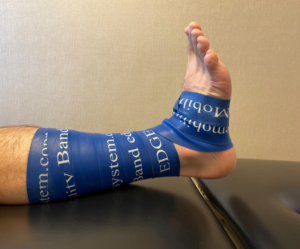 The mobility band technique, commonly referred to as “Voodoo flossing,” is a tool used for improving joint movement, reducing soft tissue stiffness, and allowing the patient to access more available range of motion. The patient typically has a reduction in pain level, which accelerates recovery time, optimizing performance and quality of movement. The tension created with the band on that affected body part restricts blood flow to the area. Once the band is released, fresh, oxygenated blood rushes in and replaces the old, damaged cells. This process aids in speeding up the processes that occur in healing. The compression from the tension allows the patient to have greater stability which then leads to improved mobility.
The mobility band technique, commonly referred to as “Voodoo flossing,” is a tool used for improving joint movement, reducing soft tissue stiffness, and allowing the patient to access more available range of motion. The patient typically has a reduction in pain level, which accelerates recovery time, optimizing performance and quality of movement. The tension created with the band on that affected body part restricts blood flow to the area. Once the band is released, fresh, oxygenated blood rushes in and replaces the old, damaged cells. This process aids in speeding up the processes that occur in healing. The compression from the tension allows the patient to have greater stability which then leads to improved mobility.
Rock Tape / Kinesiotaping
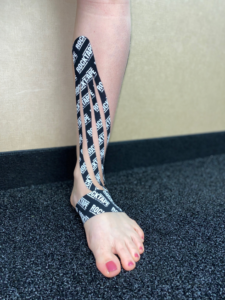 Kinesiotape is a skin-like material that mimics the same movement of skin. It provides a microscopic lifting effect underneath the skin and in between the layers that allows inflammation and swelling to be removed at a quicker rate. By giving the tissue support and improving one’s proprioception, this delays fatigue and helps with normalization of movement. Taping can be a great addition when combined with other techniques including neuromuscular re-education and restorative exercises to improve overall function.
Kinesiotape is a skin-like material that mimics the same movement of skin. It provides a microscopic lifting effect underneath the skin and in between the layers that allows inflammation and swelling to be removed at a quicker rate. By giving the tissue support and improving one’s proprioception, this delays fatigue and helps with normalization of movement. Taping can be a great addition when combined with other techniques including neuromuscular re-education and restorative exercises to improve overall function.
